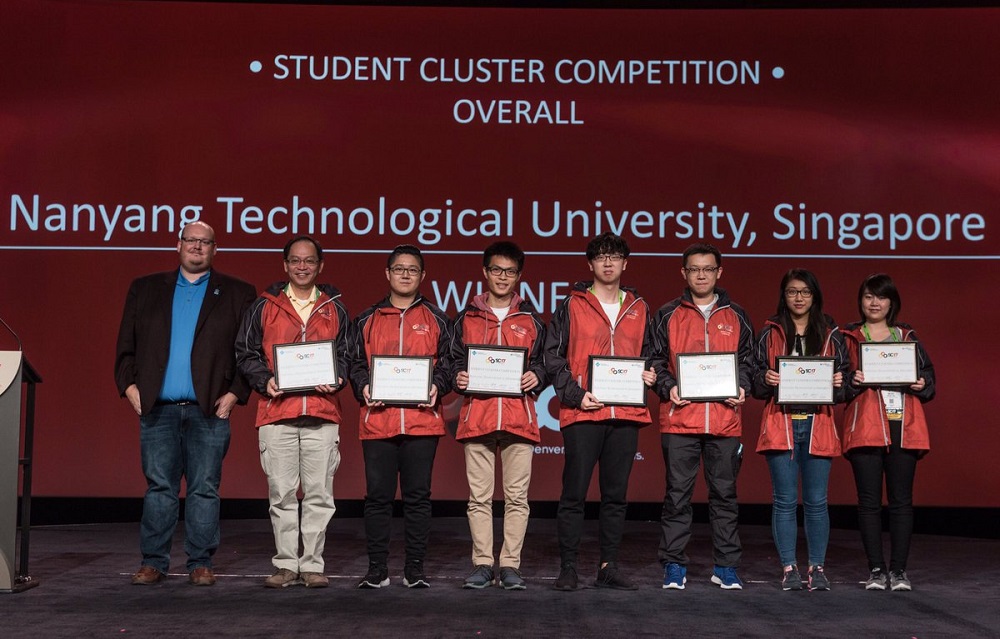After a jam-packed four-day expo and intensive six-day technical program, SC17 has wrapped up another successful event that brought together nearly 13,000 visitors to the Colorado Convention Center in Denver for the largest HPC conference in the world. In keeping with the conference theme of HPC Connects, General Chair Bernd Mohr of Juelich Supercomputing Center, the event’s first international chair, advanced strong global attendance: there were 2,800 international attendees from 71 countries, including 122 international exhibitors.
Asked what they liked most about the 29th annual Supercomputing Conference, you’ll get a lot of folks geeking out over the technology but ultimately it’s the community that keeps them coming back to connect with old friends and meet new ones. Other fan favorites that had attendees buzzing this year were the electrifying student cluster competition (with first-ever planned power shutoffs!), record-setting SCinet activities, impressive Gordon Bell results and an out-of-this-world keynote; plus a lineup of 12 invited talks, including a presentation by the supercomputing pioneer himself, Gordon Bell.
 On Tuesday morning, SC17 Chair Mohr welcomed thousands of SC attendees to the conference center ballroom to share conference details and introduce the SC17 keynote, “Life, the Universe and Computing: The Story of the SKA Telescope.” In front of a stunning widescreen visual display, Professor Philip Diamond, director general of the international Square Kilometer Array (SKA) project, and Dr. Rosie Bolton, SKA Regional Centre project scientist, described the SKA’s vision and strategy to map and study the entire sky in greater detail than ever before. We think this will go down as one of the best keynotes in SC history, so don’t miss our feature, “HPC Powers SKA Efforts to Peer Deep into the Cosmos.”
On Tuesday morning, SC17 Chair Mohr welcomed thousands of SC attendees to the conference center ballroom to share conference details and introduce the SC17 keynote, “Life, the Universe and Computing: The Story of the SKA Telescope.” In front of a stunning widescreen visual display, Professor Philip Diamond, director general of the international Square Kilometer Array (SKA) project, and Dr. Rosie Bolton, SKA Regional Centre project scientist, described the SKA’s vision and strategy to map and study the entire sky in greater detail than ever before. We think this will go down as one of the best keynotes in SC history, so don’t miss our feature, “HPC Powers SKA Efforts to Peer Deep into the Cosmos.”
 In his introduction, Mohr pointed out that the discovery of gold about five miles away from the conference site in 1858 led to the founding of Denver. “[It] is fitting,” said Mohr” because today high performance computing is at the forefront of a new gold rush, a rush to discovery using an ever-growing flood of information and data. Computing is now essential to science discovery like never before. We are the modern pioneers pushing the bounds of science for the betterment of society.”
In his introduction, Mohr pointed out that the discovery of gold about five miles away from the conference site in 1858 led to the founding of Denver. “[It] is fitting,” said Mohr” because today high performance computing is at the forefront of a new gold rush, a rush to discovery using an ever-growing flood of information and data. Computing is now essential to science discovery like never before. We are the modern pioneers pushing the bounds of science for the betterment of society.”
 One of the marvels of the show each year is SCinet, the fastest most powerful scientific network in the world for one week. This year SCinet broke multiple records, achieving 3.63 Tbps of bandwidth, as well as the most floor fiber laid and most circuits ever. SCinet takes three weeks to set up and operates with over $66 million in loaned state-of-the-art equipment and software. In the weeks ahead, we will have more coverage on how this fascinating feat is pulled off as well as the ground-breaking networking research that is enabled.
One of the marvels of the show each year is SCinet, the fastest most powerful scientific network in the world for one week. This year SCinet broke multiple records, achieving 3.63 Tbps of bandwidth, as well as the most floor fiber laid and most circuits ever. SCinet takes three weeks to set up and operates with over $66 million in loaned state-of-the-art equipment and software. In the weeks ahead, we will have more coverage on how this fascinating feat is pulled off as well as the ground-breaking networking research that is enabled.
The 50th edition of the Top500, covered in-depth here, was announced on Monday. The list will go down in history as the year China pulled ahead in multiple dimensions, not just with the number one system (which China has claimed for ten consecutive lists), but with the highest number of systems and largest flops share.
A roundup of benchmark winners from SC17:
Top500: China’s Sunway TaihuLight system (93 petaflops)
Green500: Japan’s RIKEN ZettaScaler Shoubu system B (17 gigaflops/watt)
HPCG: Japan’s RIKEN K computer (0.6027 petaflops)
Graph500: Japan’s RIKEN K computer
For the second year, China won the coveted Gordon Bell prize, the Nobel prize of supercomputing presented by the Association for Computing Machinery each year in association with SC. The 12-member Chinese team employed the world’s fastest supercomputer, Sunway TaihuLight to simulate 20th century’s most devastating earthquake, which occurred in Tangshan, China in 1976. The research project “18.9-Pflops Nonlinear Earthquake Simulation on Sunway TaihuLight: Enabling Depiction of 18-Hz and 8-Meter Scenarios” achieved greater efficiency than had been previously attained running similar programs on the Titan and TaihuLight supercomputers. You can read about the important practical implications of this work in the ACM writeup.

In an awards ceremony Thursday the team from Nanyang Technological University took the gold in the Student Cluster Competition. With its dual-node Intel 2699-based cluster accelerated with 16 Nvidia V100 GPUs, the team from Singapore pulled off a triple-play, also recording record runs for both Linpack and HPCG. At 51.77 TFlop/s the team’s SC17 Linpack score beat the previous record by nearly 40 percent and its HPCG score of 2,055.85 was a nearly 50 percent improvement over the previous record-holder. Among the competitors this year who deserve honorable mention are the first all-high school team from William Henry Harrison High. Check back next week for more extensive coverage of the contest and a rundown of the winning teams from our roving contest reporter Dan Olds.

The HPCwire editorial team would like to congratulate everyone on their achievements this year. And we applaud our HPCwire Readers’ and Editors’ choice award winners, a diverse and exceptional group of organizations and people who are on the cutting-edge of scientific and technical progress. (The photo gallery of award presentations can be viewed on Twitter.)
We look forward to seeing many of you in June at the International Supercomputing Conference in Frankfurt, Germany, and then in Dallas for SC18, November 11-16, when SC will be celebrating its 30th anniversary (i.e., its 30th “birthday,” and 31st conference). The SC18 website is already live and the golden key has been handed to next year’s General Chair Ralph A. McEldowney of the US Department of Defense HPC Modernization Program. If you’re partial to the Mile High City, you’re in luck because SC will be returning to Denver in 2019 under the leadership of University of Delaware’s Michela Taufer, general chair of the SC19 conference.
Stay tuned in the coming weeks as we release our SC17 Video Interview series.





























































